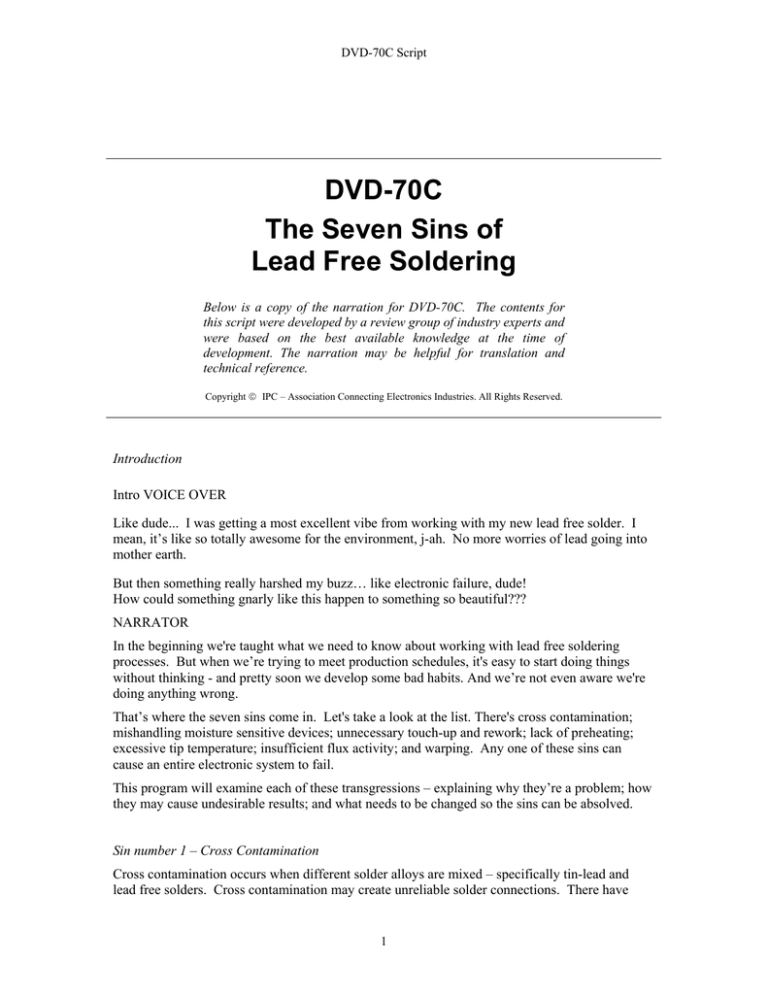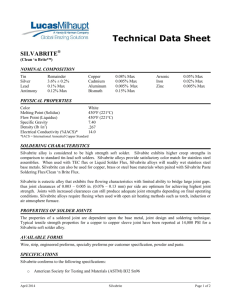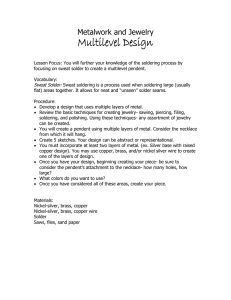
DVD-70C Script
DVD-70C
The Seven Sins of
Lead Free Soldering
Below is a copy of the narration for DVD-70C. The contents for
this script were developed by a review group of industry experts and
were based on the best available knowledge at the time of
development. The narration may be helpful for translation and
technical reference.
Copyright © IPC – Association Connecting Electronics Industries. All Rights Reserved.
Introduction
Intro VOICE OVER
Like dude... I was getting a most excellent vibe from working with my new lead free solder. I
mean, it’s like so totally awesome for the environment, j-ah. No more worries of lead going into
mother earth.
But then something really harshed my buzz… like electronic failure, dude!
How could something gnarly like this happen to something so beautiful???
NARRATOR
In the beginning we're taught what we need to know about working with lead free soldering
processes. But when we’re trying to meet production schedules, it's easy to start doing things
without thinking - and pretty soon we develop some bad habits. And we’re not even aware we're
doing anything wrong.
That’s where the seven sins come in. Let's take a look at the list. There's cross contamination;
mishandling moisture sensitive devices; unnecessary touch-up and rework; lack of preheating;
excessive tip temperature; insufficient flux activity; and warping. Any one of these sins can
cause an entire electronic system to fail.
This program will examine each of these transgressions – explaining why they’re a problem; how
they may cause undesirable results; and what needs to be changed so the sins can be absolved.
Sin number 1 – Cross Contamination
Cross contamination occurs when different solder alloys are mixed – specifically tin-lead and
lead free solders. Cross contamination may create unreliable solder connections. There have
1
DVD-70C Script
been studies that show that certain lead free and tin-lead mixed solder joints develop cracks and
other types of physical instabilities. There is also evidence that cross contamination can even
become a reliability issue when different lead free alloys are mixed.
But the biggest problem with mixing tin-lead and lead free solders is that it will make our
electronic assemblies and electronic products non-compliant with European Union standards.
Companies that are found non-compliant will not have their products accepted. As you can
imagine, this situation would be financially crippling.
Cross contamination can occur in a number of manufacturing situations – and if we’re not paying
attention, we may not realize what’s happening until it’s too late. For example, some solder paste
printing machines may be used for the application of both tin-lead and lead free solder paste.
When we’re working hard to meet production deadlines, it is possible to inadvertently mix the
different alloys.
That’s why it’s so important to thoroughly clean the stencil printer before setting up to run lead
free product. It’s also important to use the same lead free alloy when adding paste to the stencil.
During wave soldering, cross contamination is less of an issue. That’s because most companies
are using separate solder pots – rather than take the chance of cross contamination.
But even when machines are cleaned and there’s no threat of mixing the alloys, there is some risk
of cross contamination. This risk involves bare circuit boards and component leads that may not
have lead free finishes.
When tin-lead components are soldered with lead free alloys, there is a potential for unreliable
solder joints. These contaminated assemblies may pass an initial electrical test, but may fail later
on due to the unreliable solder connections. This would obviously create unhappy and frustrated
customers.
During rework and repair, it can be even harder to control cross contamination. That’s because
we’ll need to know which lead free alloy was used during the soldering operation. You’d think
this wouldn’t be too difficult if we’re simply touching up solder joints that exhibit insufficient
solder – since these connections were just soldered. But your company may be running leaded
and lead free assemblies at the same time on different machines. Solder technicians have to know
which assembly is which. That’s why it’s important to check the traveler before touching up the
assembly.
But it is much more difficult to track the type of solder used when assemblies are returned for
repair from the field. It’s also important to make sure that replacement components have lead
free finishes. In an ideal world lead free components will be marked so that you’ll know they’re
lead free. For example, components may be marked with the lead free symbol; the words lead, or
Pb free; or with the designation for the type of lead free finish on the component leads. But there
are some chip components that have no marking and appear identical – regardless of whether
they’re tin-lead or lead free. It’s important to follow your company’s policy with regard to
mixing any solder alloys. Finally, make sure to use tools that are designated for lead free only.
2
DVD-70C Script
Sin number 2 – Mishandling Moisture Sensitive Devices
One of the more dastardly sins in lead free assembly is the mishandling of moisture sensitive
devices. These components are at even greater risk because of the higher soldering temperatures
used during the lead free process.
When we’re in the midst of our busy day, we may not take the time to check the humidity
indicator card after removing components from moisture barrier bags. Or we may forget to add
fresh desiccant and to reseal the bags in a timely manner.
In addition, it may slip our mind to examine the moisture sensitive label that specifies moisture
classification, storage time and floor life. We may also not be aware when the floor life of MSDs
has been exceeded. Rather than properly baking the components that have exceeded time limits,
we allow devices with excessive moisture to be reflow soldered. The combination of high
soldering temperatures and moisture inside the device creates the probability of component
failure.
Let’s quickly review what determines whether a component is moisture sensitive – and why the
accumulation of moisture can be a problem. Moisture sensitive means there is not a perfect seal
between the internal circuitry and the package that surrounds it. These types of components are
not hermetically sealed like a ceramic component would be.
Many common surface mount plastic packages are at risk – including small outline integrated
circuits, or SOICs; quad flat packs, or QFPs; plastic leaded chip carriers, or PLCCs; and ball grid
arrays, or BGAs. The more complex and intricate the inside of the component is, the more
sensitive the component becomes. When these types of packages are exposed to a typical factory
environment, moisture can accumulate inside the package.
The reason moisture accumulation is a problem is the vapor pressure of the moisture inside the
package greatly increases when the device is exposed to high temperatures during reflow
soldering operations.
The exposure to these high temperatures and increased internal vapor pressures can result in the
package cracking or the delamination of internal interfaces within the package. This is usually
called popcorning.
In order to control and prevent problems from occurring during surface mount assembly or any
type of hot air rework, it’s important to do the following. Moisture sensitive devices need to be
stored in moisture barrier bags, along with active desiccant and a humidity indicator card.
When the humidity indicator card reveals that the allowed relative humidity has been exceeded,
the components will need to be baked per the time periods specified in J-STD-033 – or your
company’s standard operating procedure.
Carrier materials that components are stored in – such as trays, tubes and reels – can also affect
the moisture level in the moisture barrier bag. If these materials are not baked, extra desiccant
will need to be added to the moisture barrier bag.
Exposing moisture sensitive components to the factory environment should be kept to a minimum
during the assembly process. Floor life often becomes an issue for MSDs when another hot job is
needed – and reels, trays and tubes have to be switched out to run that new job. If the exposure to
the factory environment exceeds the specified time, then the MSDs will need to go through a
3
DVD-70C Script
baking operation – often 48 hours – before they can be safely reflow soldered, or be returned to
the stockroom. Check J-STD-033, or your company’s standard operating procedures for proper
baking times and temperatures.
If we forget to keep track of how long any moisture sensitive devices are exposed to the
environment, then we run the risk of undetected damage to the components when they are reflow
soldered. Protecting moisture sensitive devices can be critical to the quality and reliability of the
electronic assemblies we’re manufacturing.
Sin number 3 – Unnecessary Touch-Up and Rework
When we evaluate lead free solder connections, there’s a tendency to want to touch up the solder
because the lead free connections may not look like the tin-lead solder joints we’re used to
seeing.
For example, cosmetic imperfections such as cooling lines, fillet lifting, tears and the overall
grainy appearance that are common to lead free solder joints make it seem like a little touch up or
rework is required.
But these imperfections do not necessarily affect the reliability of the connection. You may ask,
“what’s the harm in creating something beautiful?”
What’s important to understand is that when we touch up or rework a connection, we actually
weaken the joint – even though it may look better. That’s because every time heat is applied to
the connection, it will increase the growth of the intermetallic layer.
The intermetallic layer is a thin copper-tin compound created when the solder bonds to the copper
land and the component lead or termination. While the intermetallic layer is the critical and
necessary part of the connection forming the bond – excessive intermetallics will cause solder
joint strength to be reduced. This is because the intermetallic portion of the solder joint is more
brittle than the rest of the joint.
Therefore, the thicker the intermetallic becomes, the more prone it is to a physical failure such as
cracking. This defect is invisible to the eye. You won’t even know the solder joint is degrading
until it's too late – meaning a failure occurs.
That’s why unnecessary touch up and rework is such a grievous sin. The rule of thumb is to
never perform any rework operation that is not required by your company’s documented process
controls. The latest revision of the IPC-A-610 has pictures of acceptable lead free solder joints.
Sin number 4 – Lack of Preheating
This sin relates exclusively to rework since both reflow and wave soldering machines contain
preheat sections that are part of the overall thermal profile for those soldering operations. With
most tin-lead solder joints, rework is accomplished by simply removing and replacing the
component, and then resoldering the connection.
But this process isn’t always successful with lead free rework – especially hot air operations –
where the higher soldering temperatures and poorer wetting characteristics create the potential for
heat damage to both the component and the circuit board.
4
DVD-70C Script
Heat damage can occur during both the component removal and soldering operations. It’s
important to understand that thermal damage isn’t the only issue. When we use the drag
soldering technique at room temperature, there is a tendency to produce multiple solder bridges in
a lead free process.
The best way to avoid or minimize these types of problems is to preheat the assembly.
Preheating will allow us to complete the soldering operation more quickly, thereby reducing the
risk of heat damage and other types of soldering defects. At many companies, rework technicians
place the assembly on a bottom side preheater, and perform all of the rework operations from that
position.
Sin number 5 – Excessive Tip Temperatures
This sin is a cousin to our last transgression – no preheating. It involves point-to-point hand
soldering touch up and rework operations. Let’s examine the problem.
Because of the higher melting temperature for lead free alloys, many trained solder technicians
believe that if they are not getting the connection area up to solder melt temperature quickly, then
they must increase the soldering iron tip temperature to get the alloy to melt faster.
But increasing the tip temperature to overcome slow heating of the connection area can cause
localized overheating of the connection and result in lifted lands, overheated solder and board
damage.
A variation of this sin occurs when we feel the need to press down in order to transfer more heat
to complete the connection. But pressing harder doesn't make the connection heat up any faster.
In fact, it has nothing to do with how quickly the heat transfers from the soldering iron to the
connection.
One solution is to select a different tip – one that has an increased contact area. The increased
contact area will allow the connection to heat more rapidly without increasing the tip temperature.
Another possibility is to use auxiliary heating to preheat the area to be soldered. As we stated in
our previous sin, preheating makes it easier to solder a connection that requires more heat.
Again, you won’t have to raise the tip temperature. In some cases just a slight increase in dwell
time, or the time the soldering iron is in contact with the connection area, will create an
acceptable lead free solder joint.
The rule of thumb is that we want to use the lowest soldering temperature possible to avoid
damaging the assembly. Yet the temperature of the iron must be sufficient to adequately heat the
lead free solder joint and to allow solder to melt and wet all connection elements.
Sin number 6 – Insufficient Flux Activity
When the flux being used isn’t robust enough for the higher lead free soldering temperatures,
there can be problems. The flux can burn up and not do its job of cleaning the surfaces of the
connection and transferring the heat effectively. The result may be oxidation and longer
soldering times.
5
DVD-70C Script
Using a more robust flux will allow the connection surfaces to be properly cleaned. And there
will be better heat transfer – which will compensate for the reduced spreading of the lead free
solder alloys.
But this sin doesn’t simply end with selecting the appropriate flux. Using too much flux is up
near the top of the list for flux problems. Excessive quantities of flux used during soldering may
introduce long-term reliability problems such as corrosion and electromigration.
Corrosion breaks down the metal. Corrosion is caused by the acid in the flux, along with other
by-products of the residue. Electromigration is the growth of metal dendrites in the presence of
flux residues. These dendrites can grow from one circuit trace to another and cause short circuits.
It's important to realize the hand soldering process itself fosters excessive use of flux - since
there's less control of the flux application. It's not unusual to see a large increase in the amount of
flux residue when compared to modern, efficient flux applicators for wave soldering. As you can
imagine, using too much flux will increase the burden on the post soldering cleaning process.
The more robust, or active fluxes also have an impact on cleaning. When these fluxes are used,
the flux residues tend to be more difficult to remove – therefore requiring a more thorough
cleaning process. It’s important to clean the lead free connections immediately after soldering.
Sin number 7 – Warping
Lead free reflow and wave soldering can be the culprits for our final sin – although board
warping can also occur during hot air rework operations. The problem can occur because the
peak lead free soldering temperatures are up to 40 degrees C higher than tin-lead soldering
processes.
With higher soldering temperatures, circuit board assemblies may sag or warp – rendering them
unfit for customer shipment. That’s because the distorted assembly won’t connect properly inside
the equipment chassis and may contact adjacent devices. There is no repairing a warped
electronic assembly. What remains is a pile of scrapped materials.
In order to control the possibility of warping, bowing, sagging – or any other distortion – board
supports and/or stiffeners may be required during reflow and wave soldering. It’s important to
check your documentation to see if supports are needed – and to use them.
Summary
You’ve just taken a refresher course on how to avoid the most common pitfalls in lead free
soldering. Remember, the seven sins include cross contamination; mishandling moisture
sensitive devices; unnecessary touch-up and rework; lack of preheating; excessive tip
temperature; insufficient flux activity; and warping.
It’s important to be aware of the characteristics and appearance of the lead free alloys, and the
effect that higher soldering temperatures have on circuit boards and components.
6
DVD-70C Script
VOICE OVER
Like I’ve totally learned a real important lesson… it’s not enough to use lead free solder, you
also got to use it the right way, man! That, and switching back to vinyl. Righteous!
7


